Cotyledon Linneaus (1753)
Greek: kotyledon = cup-shaped hollow
Cotyledon is a genus of 10 species of perennial shrubby leaf and stem succulents from South Africa, with numerous varieties and cultivars. Cotyledon has been a catch-all genus including species from Echeveria, Rosularia, Tylecodon and Umbilicus, now all grouped separately. Tölken (1978) separated 47 species of Tylecodon with seasonal, spirally-arranged leaves from Cotyledon with perennial leaves. The name Tylecodon is an angram of Cotyledon. As taxonomic fashions change and with new insights from DNA analysis, it is possible that the scope of Cotyledon will change again. Some confusion over species validly included in Cotyledon still exists on plant labels and across the internet.
Cotyledons generally colonise rocky ground and cliff faces, a clue that they appreciate well-drained conditions in cultivation. The fleshy leaves of some species (e.g. Cotyledon ladismithensis) are slightly pubescent or farinose (e.g. Cotyledon ladismithensis, Cotyledon orbiculata). The orange flowers of Adromischus phillipsiae are similar to those of Cotyledon, with which it was once grouped.
Cultivation: Cotyledons are easy to grow in any free-draining gritty compost and grow well on a sunny window ledge or greenhouse. These plants are suitable for gardens in a Mediterranean climate. Stems can be carefully pruned to maintain an attractive shape. Cotyledons tolerate cool, frost-free conditions during the winter if kept dry. It is best to keep water off the leaves.
Mealy bugs and vine weevils can be discouraged with a systemic insecticides based on Imidacloprid e.g. Provado Vine Weevil Killer. Crassulaceae are generally intolerant of the contact insecticide Malathion.
Cotyledons should be regarded as poisonous as the closely related Tylecodons.
|
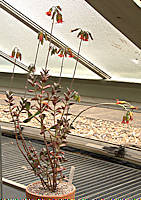
RBG Kew |
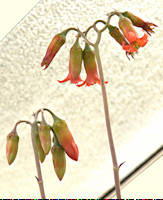 |
Cotyledon adscendens Dyer 1949 (Red-margined Cotyledon)
Name: Latin adscendens = ascending, referring to its scrambling habit.
This small shrubby plant has opposite pairs of obovate leaves with reddened margins. The inflorescence is a cluster of hanging orange bells on a long stem.
Native to the Eastern Cape of South Africa near to Port Elizabeth.
C. adscendens is very similar to C. woodii except that the inflorescence of the latter is often reduced to a single flower close to the upper leaf axil.
|
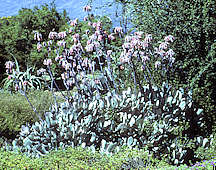 |
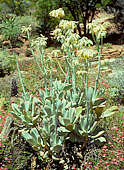 |
Cotyledon orbiculata Linnaeus 1753 (Afrikaans: 'Plakkie'= pig's ear)
Cotyledon orbiculata includes numerous plants formerly regarded as separate species, currently grouped into five variable subspecies.
This common roadside weed in the Cape Province has large flat bluish-grey fleshy leaves with reddened margins. The leaves nicely offset umbels of pink, orange or yellow tubular cup-shaped flowers held on long stems. The flowers are bird pollinated.
Left: Karoo Botanic Garden, Worcester, RSA.
|
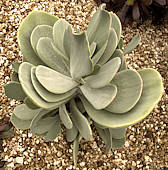 |
Cotyledon orbiculata is native to Southern Africa but cultivated in warm climates world-wide, with numerous selected, named forms in cultivation. This plant is a traditional treatment for warts and abscesses.
Left: Seen on a display by Trewidden Nursery.
|
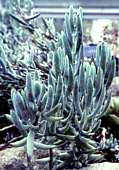
RBG Kew |
Cotyledon orbiculata var orbiculata Linnaeus 1753
Syn. Cotyledon decussata Sims 1824
This variety of Cotyledon orbiculata includes numerous shrubby plants formerly regarded as separate species. The leaves are variable in form but generally of an oval shape, usually smooth but sometimes with a degree of pubescence. Leaf margins and tips are often reddened. The umbels of tubular flowers are in shades of yellow to red and produced in the Spring and Summer.
Native to Angola, Namibia and South Africa.
|
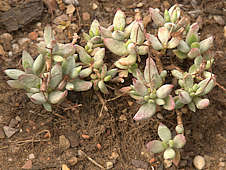
RBG Kew |
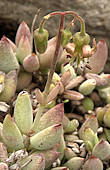
|
Cotyledon papillaris Linnaeus f. 1782
This dwarf Cotyledon has small ovate green to pinkish-grey leaves. The inflorescence is a short, sticky stem bearing a small cluster of greenish-orange bells with recurved petal tips. The flower stem, sepals and petal outsides are pubescent.
Native to Namibia and the Cape Province of South Africa.
|
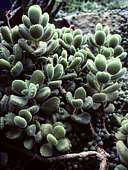
RBG Kew |
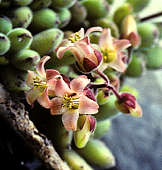
|
Cotyledon tomentosa ssp. ladismithensis Tölken 1977
Named for: type habitat around Ladismith in the Western Cape.
A low-growing shrub from the Western Cape of South Africa and quite common in collections of succulent plants. Lower branches have peeling bark. The oblong leaves have flattened upper surfaces and rounded undersides. The ends of the leaves are undulate, sometimes reddened and all surfaces are pubescent. Clusters of pink to orange tubular flowers are produced during the Summer.
|

 Families of Succulent Plants
Families of Succulent Plants Crassulaceae
Crassulaceae 


 Families of Succulent Plants
Families of Succulent Plants Crassulaceae
Crassulaceae 
